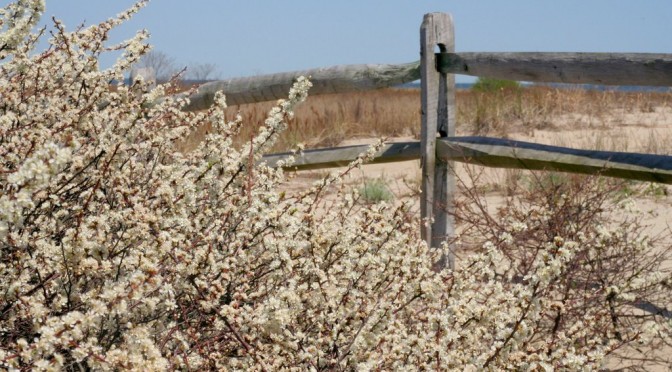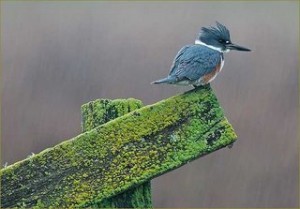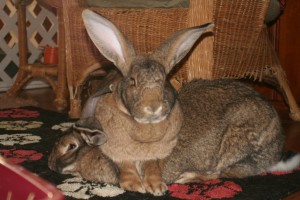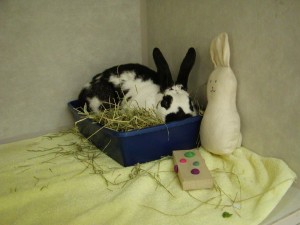 Dora is at the vet’s tonight.
Dora is at the vet’s tonight.
🙁
I took the afternoon off from work and brought her in to the vet because she’s been acting *off* the last day or two and not eating like she should and not pooping. Bad news for a bunny.
The photo at left is her in her hospital cage zonked out on pain meds. I visited her tonight after my final meeting with students and brought a special salad with her favorite veggies and her toys. All of which she ignored. I hate to leave a bunny in the hospital, especially one as sensitive as my Dora, because being away from home causes its own problems. So a bunny who was not eating well is now not eating at all because she is timid and fearful in an unfamiliar place and is zonked out on pain meds. Pain medication is important for a rabbit who is ill, so I should be glad that my vet is willing to give it, because many vets do not routinely give pain meds to rabbits. Even after spay/neuter procedures – can you imagine? I have to convince myself that the she needs to be there, even if it means that she will get worse before she can get better.
She is being treated for GI Stasis and needs subQ fluids and injectable meds. I’ve done those things at home with other bunnies, but not with a bunny quite like Dora. She’s only been with me for 6 months or so and will not be handled. I can pet her and kiss her and play with her, but heaven forbid I even think about picking her up and she bolts. No way can I hold her down to give her shots, or hold her still for subQ fluids. So I left her there tonight, hoping that the meds will do their work and get her digestive system working properly, so that I can bring her home with me.
All posts by laurahinnj
Singing lessons (for Linda)
 My ears are much better than my eyes at identifying birds. My distance vision is not good and I’m too vain to wear my eyeglasses other than when I’m driving. I find glasses especially uncomfortable with binoculars. Because I have trouble spotting the movement of birds, I’ve come to rely on my ears more than my eyes and have tried over the years to develop my knowledge of bird songs. It’s a handy skill to have (and a good way to impress non-birding friends) and is easy to do if you’re an auditory person like me. I’ve always learned best by listening and in school was often reprimanded for *daydreaming*, when in fact I was paying close attention with my ears rather than my eyes.
My ears are much better than my eyes at identifying birds. My distance vision is not good and I’m too vain to wear my eyeglasses other than when I’m driving. I find glasses especially uncomfortable with binoculars. Because I have trouble spotting the movement of birds, I’ve come to rely on my ears more than my eyes and have tried over the years to develop my knowledge of bird songs. It’s a handy skill to have (and a good way to impress non-birding friends) and is easy to do if you’re an auditory person like me. I’ve always learned best by listening and in school was often reprimanded for *daydreaming*, when in fact I was paying close attention with my ears rather than my eyes.
In the sprin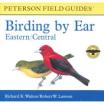 g I like to *warm-up* my ears to warbler song by listening to birdsong cd’s. This way I avoid the frustration of hearing birds that I can’t see while still knowing who’s out there singing. I like to play the cd’s at bedtime and usually fall asleep to their sweet seranade. I also make a *cheat sheet* that I carry with me when birding to help me distinguish between certain birds that I have trouble with. My favorites are the “Peterson’s Birding by Ear” and “Peterson’s More Birding by Ear”.
g I like to *warm-up* my ears to warbler song by listening to birdsong cd’s. This way I avoid the frustration of hearing birds that I can’t see while still knowing who’s out there singing. I like to play the cd’s at bedtime and usually fall asleep to their sweet seranade. I also make a *cheat sheet* that I carry with me when birding to help me distinguish between certain birds that I have trouble with. My favorites are the “Peterson’s Birding by Ear” and “Peterson’s More Birding by Ear”.
My friend Linda at work wants to learn about birds and I’ve offered to bring her along on a spring walk. She’s dissuaded by the early hour and suggests we have brunch, then bird, and finish up with some shopping. We have a running joke where she *sings* a bird song that she heard that morning to me and I’m supposed to tell her what it is that she heard. Somehow all of her *songs* sound the same. This morning she saw a cardinal and I tried to teach her its song as “Tear-tear-tear.” With her Brooklyn accent it turned into something unrecognizable, but we’ll keep working on it.
A LISTENER’S GUIDE TO THE BIRDS by E.B. White
Wouldst thou know the lark?
Then hark!
Each natural bird
Must be seen and heard.
The lark’s “Tee-ee” is a tinkling entreaty.
But it’s not always “Tee-ee” –
Sometimes it’s “Tee-titi.”
So watch yourself.
Birds have their love-and-mating song,
Their warning cry, their hating song;
Some have a night song, some a day song,
A lilt, a tilt, a come-what-may song;
Birds have their careless bough and teeter song
And, of course, their Roger Tory Peter song.
The studious ovenbird (pale pinkish legs)
Calls, “Teacher, teacher, teacher!”
The chestnut-sided warbler begs
To see Miss Beecher.
“I wish to see Miss Beecher.”
(Sometimes interpreted as “Please please please ta
meetcha.”)
The redwing (frequents swamps and marshes)
Gurgles, “Konk-la-ree,”
Eliciting from the wood duck
The exclamation “Jeeee!”
(But that’s the male wood duck, remember.
If it’s his wife you seek,
Wait till you hear a distressed “Whoo-eek!”)
Nothing is simpler than telling a barn owl from a veery:
One says, “Kschh!” in a voice that is eerie,
The other says, “Vee-ur” in a manner that is breezy.
(I told you it was easy.)
On the other hand, distinguishing between the veery
And the olive-backed thrush
Is another matter. It couldn’t be worse.
The thrush’s song is similar to the veery’s,
Only it’s in reverse.
Let us suppose you hear a bird say, “Fitz-bew,”
The things you can be sure of are two:
First, the bird is an alder flycatcher (Empidonax traillii
traillii);
Second, you are standing in Ohio – or as some people
call it, O-hee-o-
Because, although it may come as a surprise to you,
The alder flycatcher, in New York or New England,
does not say, “Fitz-bew,”
It says, “Wee-be-o.”
“Chu-chu-chu” is the note of the harrier,
Copied of course, from our common carrier.
The osprey, thanks to a lucky fluke,
Avoids “Chu-chu” and cries, “Chewk, chewk!”
So there’s no difficulty there.
The chickadee likes to pronounce his name;
It’s extremely helpful and adds to his fame.
But in spring you can get the heebie-jeebies
Untangling chickadees from phoebes.
The chickadee, when he’s all afire,
Whistles, “Fee-bee,” to express his desire.
He should be arrested and thrown in jail
For impersonating another male.
(There’s a way you can tell which bird is which,
But just the same, it’s a nasty switch.)
Our gay deceiver may fancy-free be
But he never does fool a female phoebe.
Oh, sweet the random sounds of birds!
The old-squaw, practising his thirds;
The distant bittern, driving stakes,
The lonely loon on haunted lakes;
The white-throat’s pure and tenuous thread-
They go to my heart, they go to my head.
How hard it is to find the words
With which to sing the praise of birds!
Yet birds, when they get singing praises,
Don’t lack for words – they know some daisies:
“Fitz-bew,”
“Konk-la-reeee,”
“Hip-three-cheers,”
“Onk-a-lik, ow-owdle-ow,”
“Cheedle, cheedle chew,”
And dozens of other inspired phrases.
Got that, Linda?
😉
Books for plant geeks
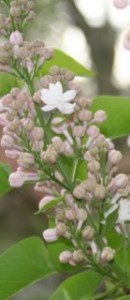 When I was a newly-minted master gardener I went out and bought two great reference books so that I would sound smart when answering questions on the helpline or during community events where we volunteer. My dear friend Debbie likes to tease me that I am never able to answer any of her gardening questions. She says that my answer is always the same, “but I don’t grow that.” Which is true; she and I have very different tastes in plant material.
When I was a newly-minted master gardener I went out and bought two great reference books so that I would sound smart when answering questions on the helpline or during community events where we volunteer. My dear friend Debbie likes to tease me that I am never able to answer any of her gardening questions. She says that my answer is always the same, “but I don’t grow that.” Which is true; she and I have very different tastes in plant material.
I guess she thinks that I ought to know everything there is to know about plants. Th e fact is, most master gardeners are just people who have an interest in gardening and are willing to volunteer their time. We’re trained in certain aspects of horticulture, but we’re not expected to know everything. Most of us have a particular interest or area of expertise, but the rest of the time our answers come from books. Knowing where to find answers is important.
e fact is, most master gardeners are just people who have an interest in gardening and are willing to volunteer their time. We’re trained in certain aspects of horticulture, but we’re not expected to know everything. Most of us have a particular interest or area of expertise, but the rest of the time our answers come from books. Knowing where to find answers is important.
Two books I use often are “Dirr’s Hardy Trees and Shrubs” and its companion “Manual of Woody Landscape Plants”. Michael Dirr has many excellent horticulture titl es, but these are the most popular. The first contains lovely glossy photos and minimal information on care; the second volume is much more detailed (and intimidating) and includes info on propagation, culture, pests and diseases, and landscape value. It also includes Dirr’s personal comments and growing experiences with each species covered. His comments and growing tips are the most enjoyable part, in my opinion.
es, but these are the most popular. The first contains lovely glossy photos and minimal information on care; the second volume is much more detailed (and intimidating) and includes info on propagation, culture, pests and diseases, and landscape value. It also includes Dirr’s personal comments and growing experiences with each species covered. His comments and growing tips are the most enjoyable part, in my opinion.
End of April
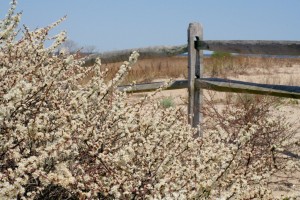 Beach Plum (Prunus maritima) at North Pond, Sandy Hook
Beach Plum (Prunus maritima) at North Pond, Sandy Hook
“By the end of April the commitment is complete. Late Spring or early, we are on our way into the fullness of mid-May, and June will come billowing across the meadows before we know it. Meanwhile there are a lot of things to be done. All the buds have to open, all the acres of chlorophyll have to be spread in the sunlight, all the early blossoms have to unfurl. The earth has to get on with its vernal business.
It is perhaps significant that April, back at the root of the word, meant “the open air,” the air out-of-doors. So it is only reasonable that we should expect much of April after Winter and March, when the open air was somewhat less than hospitable. April is an opening up, not only of the bud but of the heart, for of all the seasons this is the one in which we have the most urgent need to participate. We must have a part in the new awareness, the partnership with time and sunshine. Man is more than a shrub or a vegetabe, but he, too, needs Spring.
So, we come to the end of April, even a chilly April, with birdsong around us and some of Spring’s color; and we feel the strengthening sun, we sense the opening buds, we know again that no Winter lasts forever, no Spring skips its turn. April is a promise that May is bound to keep, and we know it.” – Hal Borland, Sundial of the Seasons, 1964.
Ag Field Day
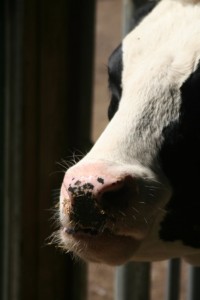 Cook College at Rutgers University has an Agriculture Field Day each year “to celebrate the unique connection between the land grant system of colleges and the communities they serve”. For me it was an excuse to take photos of cute farm animals and buy plants. I really liked the cows until one decided he wanted a taste of me and licked my arm. That was a surprise! My husband is a bit bored by my fascination with animals (honestly, I’m like a little kid and have to pet each one) – I guess because he grew up caring for horses, goats, and ducks with his parents. He was a good guy today and put up with my silliness.
Cook College at Rutgers University has an Agriculture Field Day each year “to celebrate the unique connection between the land grant system of colleges and the communities they serve”. For me it was an excuse to take photos of cute farm animals and buy plants. I really liked the cows until one decided he wanted a taste of me and licked my arm. That was a surprise! My husband is a bit bored by my fascination with animals (honestly, I’m like a little kid and have to pet each one) – I guess because he grew up caring for horses, goats, and ducks with his parents. He was a good guy today and put up with my silliness.
It was a beautiful day and we both really should have been at home working in the garden. There’s tilling to be done and fencing to fix, but I’ve wanted to see what Ag Field Day is all about for a while. All of the animals are raised and cared for by students and today was a chance for them to show off the work they do.
The Cooperative Extension and Master Gardeners a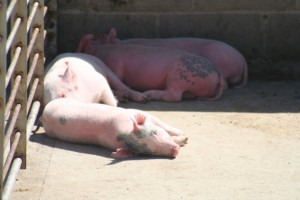 lso had a display and plant sale. We got there late so most of the heirloom tomatoes were already sold out, but I did find a few Brandywine plants and some of the Rutger’s variety that are so popular. My husband was happy to buy a few of the Angel’s Trumpets that he loves so much, but are difficult to find. We grow these in large tubs most years and try to over-winter them in the basement, but have very little luck with it. Someday we’ll find a friend with a greenhouse and some spare room for my husband’s tropical plants!
lso had a display and plant sale. We got there late so most of the heirloom tomatoes were already sold out, but I did find a few Brandywine plants and some of the Rutger’s variety that are so popular. My husband was happy to buy a few of the Angel’s Trumpets that he loves so much, but are difficult to find. We grow these in large tubs most years and try to over-winter them in the basement, but have very little luck with it. Someday we’ll find a friend with a greenhouse and some spare room for my husband’s tropical plants!
Missy is a lil’ Hot Bun!
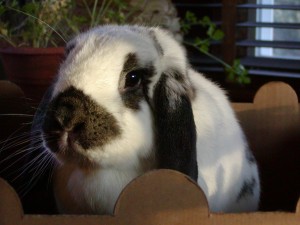 This post back in February announced the Hot Buns 2007 Calendar Contest which benefits The Rabbit Habit . The winners were announced today and my photo of Missy won! There were a total of 36 winners (out of near to 300 entries) and the 2007 calendar will include a large feature photo and 2 smaller photos for each month. Missy will be one of the small photos for the month of January. I took this photo of her atop her cardboard castle a few years ago. I really liked the warm glow of the setting sun on her face.
This post back in February announced the Hot Buns 2007 Calendar Contest which benefits The Rabbit Habit . The winners were announced today and my photo of Missy won! There were a total of 36 winners (out of near to 300 entries) and the 2007 calendar will include a large feature photo and 2 smaller photos for each month. Missy will be one of the small photos for the month of January. I took this photo of her atop her cardboard castle a few years ago. I really liked the warm glow of the setting sun on her face.
I love this contest and calendar because it features many of my friends from the PetBunny List. Quite a few of us from PB are winners.
Below are pics of other PB bunnies who won this year. Congrats everybunny!
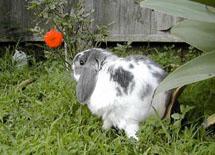
Wally (Mr. June) from Ca.
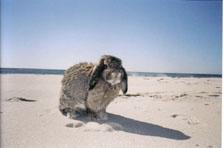
Rudy from NY
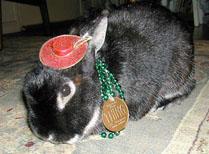
Oscar from Ca.
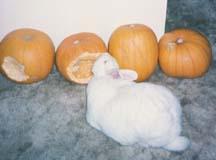
Mara Strawberry from Ca.
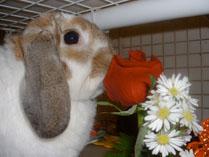
Cassidy from Tx.

Bee from Ca.
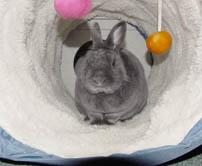
Ashy from Ca.
Dust off your cameras!
The National Wildlife Federation recently announced the winners of its 2005 photography contest and is now accepting entries for the 2006 competition. This photo of a belted kingfisher is my personal favorite, but the grand-prize winning photo, of a great gray owl, is breathtaking. Click on the photo above to see the other winning photographs. Pros, amateurs, and beginners (like me) are encouraged to enter in 8 categories ranging from birds to plants to underwater life. The talent for photography that I see daily on the blogs I frequent makes me believe that many of you should enter this contest. Go for it!
Most Beautiful Birds Meme
from John at A DC Birding Blog:
Rules: Post a list of the 10 birds you consider most beautiful on your blog; you may limit the list to the ABA area (continental United States and Canada) or use a geographic area of your choice. Mark birds you have seen with an asterisk. Tag 3 bloggers to keep it going.
My list:
Northern Parula*
Blackburnian Warbler*
American Avocet
American Kestral*
Harlequin Duck*
Red-headed Woodpecker*
Blue Jay*
Peregrine Falcon*
Oldsquaw*
Eurasion Wigeon*
I’ll tag Susan, Endment, and Pam. Have fun making your list!
Just a note to add that another NJ birding blog, The Hawk Owl’s Nest, picked up this meme. Patrick is a fellow NJ Audubon volunteer and has a great blog. Stop by and say hello.
4/26/06 Mid-week bunny fix
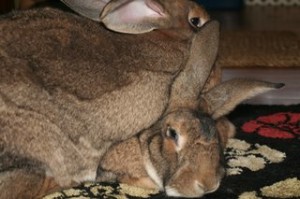
I’ve seen photos of other bunnies snuggling this way and have to say how adorable I find it. It is a little alarming to consider that Boomer weighs about 20 lbs., but Cricket is content to have Boomer nap atop of her, so long as he wakes occasionaly to wash her ears. Once she’s had enough, or can’t hold her breath any longer, she’ll back out from under him. These two are so affectionate with one another – it is a joy to witness the contentment in all their bunny *doings*.
Confusion in the early-spring garden
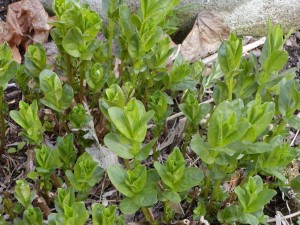 When I first started growing things I was organized. I drew plans on graph paper and kept those annoying little plastic labels next to the plants when they went into the ground. Not anymore. So many plants have died and been replaced or have simply vanished without my noticing that I’m never really sure what anything is until it blooms.
When I first started growing things I was organized. I drew plans on graph paper and kept those annoying little plastic labels next to the plants when they went into the ground. Not anymore. So many plants have died and been replaced or have simply vanished without my noticing that I’m never really sure what anything is until it blooms.
I used to be on the mailing list for a catalog that specialized in n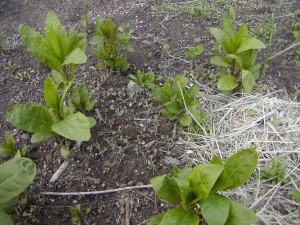 ative prairie wildflowers. A useful feature of that catalog was a little picture of what each seedling would look like after it had been growing for a while, so that the gardener wouldn’t mistakenly pull out a good plant thinking it was a weed.
ative prairie wildflowers. A useful feature of that catalog was a little picture of what each seedling would look like after it had been growing for a while, so that the gardener wouldn’t mistakenly pull out a good plant thinking it was a weed.
For the most part, I can recognize the obvious weeds, like onion grass and pigweed, but sometimes I’m not so sure. These are growing in the vegetable garden and I would like for them to be arugula (does anyone know if that is perennial?) because they almost seem to be growing in rows, but I’m afraid it’s actually pokeberry. We have a lot of that, but I don’t recognize it until it’s big and really hard to pull out.
Some plants are ea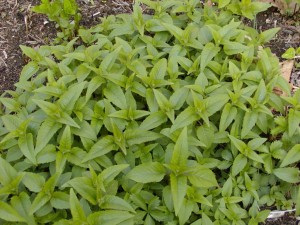 sy to recognize by the shape of their leaves or stems. This is an expanding patch of bee balm which is easy to know by its square stems. Every year it grows a bit larger and I’m careful not to pull any of it out. Any early-summer hummingbirds I get just love this plant. This one is a red variety, but I would really like to find the pale purple type that grows wild. Local nurseries sell a purple one, but it is very prone to mildew in my garden.
sy to recognize by the shape of their leaves or stems. This is an expanding patch of bee balm which is easy to know by its square stems. Every year it grows a bit larger and I’m careful not to pull any of it out. Any early-summer hummingbirds I get just love this plant. This one is a red variety, but I would really like to find the pale purple type that grows wild. Local nurseries sell a purple one, but it is very prone to mildew in my garden.
Someday I’d like to get back in the habit of labeling things. Really thoug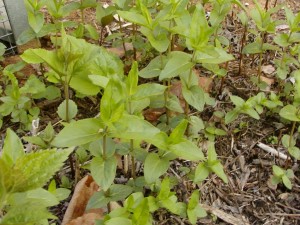 h, I enjoy the surpise of not knowing. I just wish weeding weren’t so difficult this way. Not knowing whether a plant is *good* or a weed is a handy way to procrastinate, isn’t it? I think this is Swamp Milkweed in the photo at right, but I see some little weed seedlings in the middle there trying to hide. If anyone knows if the plant on the right above is pokeberry, please do let me know!
h, I enjoy the surpise of not knowing. I just wish weeding weren’t so difficult this way. Not knowing whether a plant is *good* or a weed is a handy way to procrastinate, isn’t it? I think this is Swamp Milkweed in the photo at right, but I see some little weed seedlings in the middle there trying to hide. If anyone knows if the plant on the right above is pokeberry, please do let me know!
